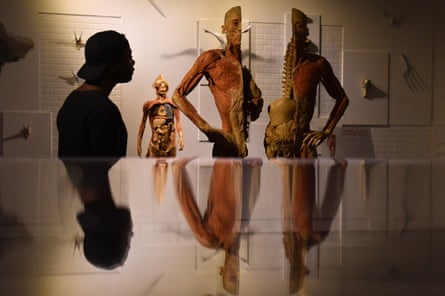A group of lawyers, academics and human rights campaigners has called on the federal government to shut down a controversial Sydney exhibition, amid claims the show could be displaying the bodies of executed Chinese political prisoners.
Protesters in Sydney have been urging a boycott of Real Bodies: The Exhibition, which showcases bodies and anatomical specimens that have been preserved through plasticisation.
The exhibition is billed as featuring the largest collection of dead bodies and human specimens to be viewed in Australia, and organisers say it has been approved by the New South Wales Department of Health.
The Imagine Exhibitions chief executive, Tom Zaller, told News Corp – which is also a media sponsor of the exhibition – earlier this month that the bodies came from China, a detail that concerns human rights activists.
Sign up to receive the top stories in Australia every day at noon
Susie Hughes, the executive director of the International Coalition to End Transplant Abuse in China (Etac), questioned whether the bodies could have possibly been ethically obtained.
The group said suggestions the bodies are “unclaimed corpses” cannot be correct. They say Chinese hospitals keep bodies for 30 days until declaring them unclaimed. The plasticisation process, however, must commence within 48 hours of death.

Vaughan Macefield, a professor of physiology at the Western Sydney University, said it was “appalling” that in 2018 such specimens from China were being displayed to members of the public who were unaware of their origin.
“Strong evidence supports the bodies and organs being exhibited having come from executed prisoners in China,” he said. “These are mostly young males on display – quite different to the older donated bodies used to teach anatomy in Australian medical schools.”
In an open letter calling on politicians to shut down the exhibition, Etac says there is “credible evidence that these are the bodies of executed prisoners and prisoners of conscience from China”.
“Using human organs and tissues without consent for financial profit is the antithesis of ethical and legal practice,” the open letter says. “Such conduct of organ trafficking and organ tourism is a serious breach of international human rights law, and Australia should have no part in it.
“We are astonished that visas and permits for bringing this exhibition into Australia were issued by the Australian government, given the lack of documentation demonstrating ethical and legal sourcing of each body. No motivation for profit or political sensitivities could ever justify such a crass and undignified violation of human rights.”

Some jurisdictions have banned similar exhibits.
The exhibition’s organisers have been contacted for comment.
Zaller told News Corp the exhibitions had been viewed by 50 million people around the world.
“They’re inspected by health departments in countless countries,” he said. “There’s no foul play.”
